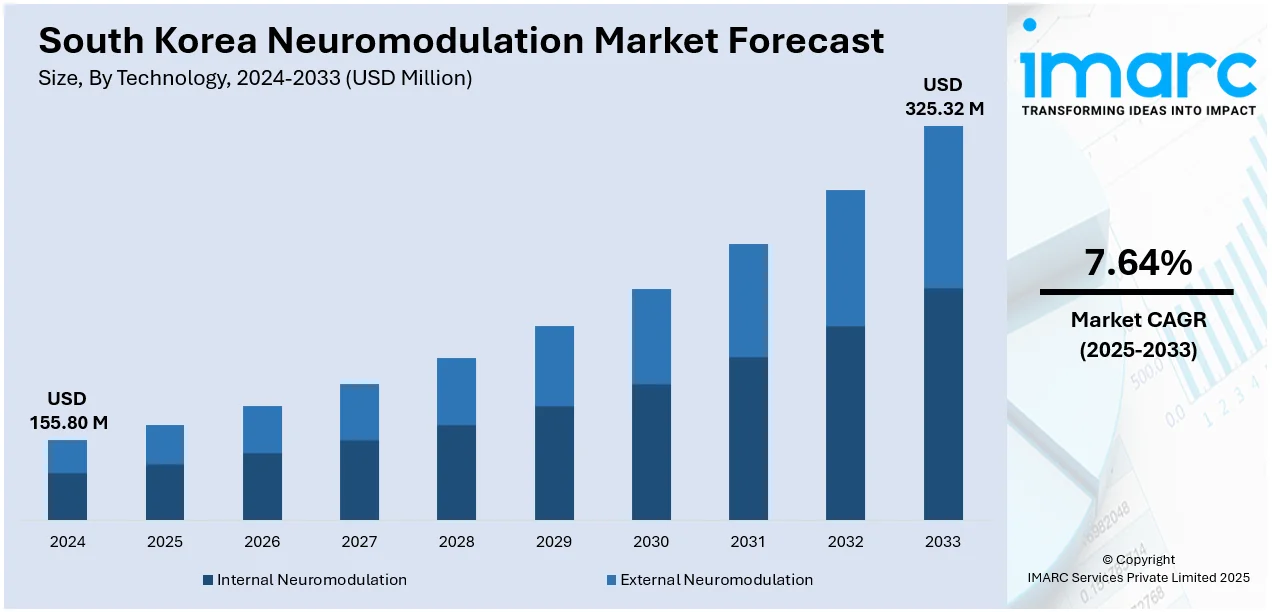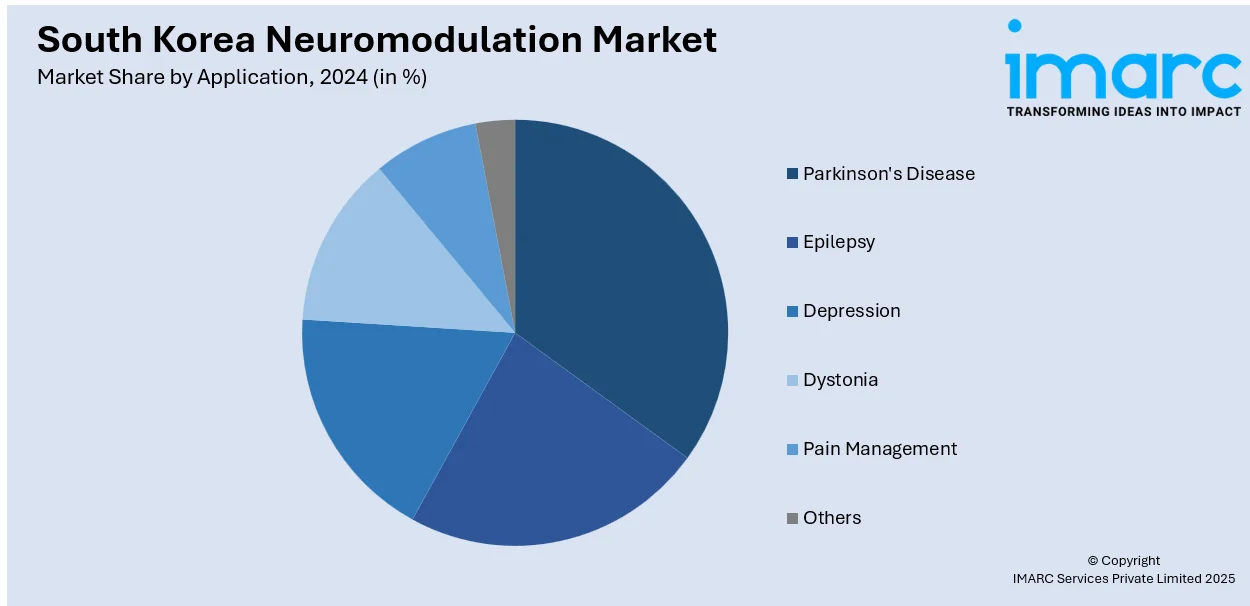
South Korea Neuromodulation Market Size, Share, Trends and Forecast by Technology, Biomaterial, Application, and Region, 2026-2034
South Korea Neuromodulation Market Overview:
The South Korea neuromodulation market size reached USD 155.80 Million in 2025. The market is projected to reach USD 325.32 Million by 2034, exhibiting a growth rate (CAGR) of 7.64% during 2026-2034. Rising cases of neurological disorders like epilepsy are catalyzing the demand for advanced minimally invasive treatments, involving neuromodulation. In addition, the broadening of specialized hospitals and neurology clinics aids in improving access to expert care and modern equipment. These centers are enhancing treatment success and supporting patient trust, thereby fueling the South Korea neuromodulation market share.
|
Report Attribute
|
Key Statistics
|
|---|---|
|
Base Year
|
2025
|
|
Forecast Years
|
2026-2034
|
|
Historical Years
|
2020-2025
|
| Market Size in 2025 | USD 155.80 Million |
| Market Forecast in 2034 | USD 325.32 Million |
| Market Growth Rate 2026-2034 | 7.64% |
South Korea Neuromodulation Market Trends:
Growing prevalence of neurological disorders
Rising prevalence of neurological disorders is positively influencing the market in South Korea. Conditions, such as epilepsy, Parkinson’s disease, chronic pain, and treatment-resistant depression, are becoming more common due to an aging population and lifestyle-related risk factors. According to the data released by the Ministry of the Interior and Safety, as of December 2024, the number of individuals aged 65 and above was 10.24 Million, representing 20% of South Korea's total population of 51 Million. As neurological disorders often lead to reduced quality of life, long-term disability, and high healthcare costs, patients and healthcare providers are actively seeking alternative therapies. Neuromodulation offers targeted, minimally invasive treatment for many of these conditions, making it the preferred option. As awareness is growing among both doctors and patients, more people are considering neuromodulation devices like spinal cord stimulators and vagus nerve stimulators as reliable solutions. Traditional treatments, including medication and surgery, may not work for every patient or may cause side effects, which further boosts interest in neuromodulation. With neurological conditions being chronic and progressive, the requirement for long-term, controllable, and adjustable therapies is rising steadily.

To get more information on this market, Request Sample
Broadening of specialized hospitals and neurology clinics
Expansion of specialized hospitals and neurology clinics is impelling the South Korea neuromodulation market growth. As more dedicated centers are opening across the country, patients with complex neurological disorders can receive expert care. In December 2024, Seoul National University Bundang Hospital (SNUBH), together with CurePSP, Inc. and GemVax & KAEL Co., Ltd., revealed plans to create South Korea's first ‘International Progressive Supranuclear Palsy (PSP) Research and Treatment Centre’. The facility would utilize the organization’s skills and facilities to promote education, treatment, and research. It would also tackle associated issues, such as behavioral and neurological disorders linked to addiction, emphasizing substance misuse. These specialized facilities are equipped with modern diagnostic tools, skilled neurologists, and trained staff who are capable of managing and delivering neuromodulation therapies effectively. With better infrastructure and clinical support, the success rate and safety of neuromodulation procedures improve, making them more acceptable to both doctors and patients. Specialized hospitals also play an important role in spreading awareness, conducting research, and training healthcare professionals, which boosts confidence in neuromodulation treatments. In urban areas, the growing number of such clinics helps reduce waiting times and makes advanced care more accessible. In addition, collaboration between the public and private sectors is facilitating the expansion of these facilities across regions.
South Korea Neuromodulation Market Segmentation:
IMARC Group provides an analysis of the key trends in each segment of the market, along with forecasts at the country and regional levels for 2026-2034. Our report has categorized the market based on technology, biomaterial, and application.
Technology Insights:
- Internal Neuromodulation
- Spinal Cord Stimulation (SCS)
- Deep Brain Stimulation (DBS)
- Vagus Nerve Stimulation (VNS)
- Sacral Nerve Stimulation (SNS)
- Gastric Electrical Stimulation (GES)
- External Neuromodulation
- Transcutaneous Electrical Nerve Stimulation (TENS)
- Transcranial Magnetic Stimulation (TMS)
- Others
The report has provided a detailed breakup and analysis of the market based on the technology. This includes internal neuromodulation (spinal cord stimulation (SCS), deep brain stimulation (DBS), vagus nerve stimulation (VNS), sacral nerve stimulation (SNS), and gastric electrical stimulation (GES)) and external neuromodulation (transcutaneous electrical nerve stimulation (TENS), transcranial magnetic stimulation (TMS), and others).
Biomaterial Insights:
- Metallic Biomaterials
- Polymeric Biomaterials
- Ceramic Biomaterials
A detailed breakup and analysis of the market based on the biomaterial have also been provided in the report. This includes metallic biomaterials, polymeric biomaterials, and ceramic biomaterials.
Application Insights:

- Parkinson's Disease
- Epilepsy
- Depression
- Dystonia
- Pain Management
- Others
The report has provided a detailed breakup and analysis of the market based on the application. This includes Parkinson’s disease, epilepsy, depression, dystonia, pain management, and others.
Regional Insights:
- Seoul Capital Area
- Yeongnam (Southeastern Region)
- Honam (Southwestern Region)
- Hoseo (Central Region)
- Others
The report has also provided a comprehensive analysis of all the major regional markets, which include Seoul Capital Area, Yeongnam (Southeastern Region), Honam (Southwestern Region), Hoseo (Central Region), and others.
Competitive Landscape:
The market research report has also provided a comprehensive analysis of the competitive landscape. Competitive analysis such as market structure, key player positioning, top winning strategies, competitive dashboard, and company evaluation quadrant has been covered in the report. Also, detailed profiles of all major companies have been provided.
South Korea Neuromodulation Market News:
- In May 2025, a clinical trial was started by Professor Jin Woo Chang at Korea University Anam Hospital in Seoul to explore the safety and effectiveness of focused ultrasound in treating psychostimulant use disorder, a significant issue related to the abuse of methamphetamine, cocaine, and other stimulants. This research would employ Insightec’s Exablate 4000 focused ultrasound system to provide noninvasive neuromodulation for studying participants.
South Korea Neuromodulation Market Report Coverage:
| Report Features | Details |
|---|---|
| Base Year of the Analysis | 2025 |
| Historical Period | 2020-2025 |
| Forecast Period | 2026-2034 |
| Units | Million USD |
| Scope of the Report |
Exploration of Historical Trends and Market Outlook, Industry Catalysts and Challenges, Segment-Wise Historical and Future Market Assessment:
|
| Technologies Covered |
|
| Biomaterials Covered | Metallic Biomaterials, Polymeric Biomaterials, Ceramic Biomaterials |
| Applications Covered | Parkinson's Disease, Epilepsy, Depression, Dystonia, Pain Management, Others |
| Regions Covered | Seoul Capital Area, Yeongnam (Southeastern Region), Honam (Southwestern Region), Hoseo (Central Region), Others |
| Customization Scope | 10% Free Customization |
| Post-Sale Analyst Support | 10-12 Weeks |
| Delivery Format | PDF and Excel through Email (We can also provide the editable version of the report in PPT/Word format on special request) |
Key Questions Answered in This Report:
- How has the South Korea neuromodulation market performed so far and how will it perform in the coming years?
- What is the breakup of the South Korea neuromodulation market on the basis of technology?
- What is the breakup of the South Korea neuromodulation market on the basis of biomaterial?
- What is the breakup of the South Korea neuromodulation market on the basis of application?
- What is the breakup of the South Korea neuromodulation market on the basis of region?
- What are the various stages in the value chain of the South Korea neuromodulation market?
- What are the key driving factors and challenges in the South Korea neuromodulation market?
- What is the structure of the South Korea neuromodulation market and who are the key players?
- What is the degree of competition in the South Korea neuromodulation market?
Key Benefits for Stakeholders:
- IMARC’s industry report offers a comprehensive quantitative analysis of various market segments, historical and current market trends, market forecasts, and dynamics of the South Korea neuromodulation market from 2020-2034.
- The research report provides the latest information on the market drivers, challenges, and opportunities in the South Korea neuromodulation market.
- Porter's five forces analysis assist stakeholders in assessing the impact of new entrants, competitive rivalry, supplier power, buyer power, and the threat of substitution. It helps stakeholders to analyze the level of competition within the South Korea neuromodulation industry and its attractiveness.
- Competitive landscape allows stakeholders to understand their competitive environment and provides an insight into the current positions of key players in the market.
Need more help?
- Speak to our experienced analysts for insights on the current market scenarios.
- Include additional segments and countries to customize the report as per your requirement.
- Gain an unparalleled competitive advantage in your domain by understanding how to utilize the report and positively impacting your operations and revenue.
- For further assistance, please connect with our analysts.
 Request Customization
Request Customization
 Speak to an Analyst
Speak to an Analyst
 Request Brochure
Request Brochure
 Inquire Before Buying
Inquire Before Buying




.webp)




.webp)












